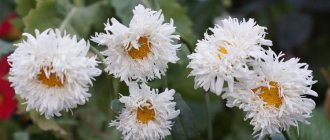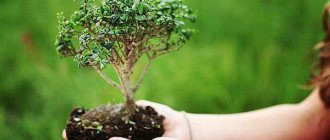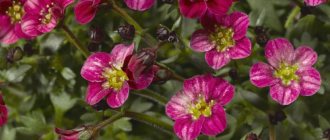Gardening » Citrus » Orange
0
1202
Article rating
Kira Stoletova
Citrus indoor plants can become a fragrant and exotic decoration for any room. Growing an orange from a seed at home is a simple and inexpensive process, so even a novice gardener can master it.
Features of growing an orange from a seed at home
Peculiarities
Let's look at the features of caring for indoor oranges at home. A tree grown from a seed blooms only at 12-15 years of age. However, it does not retain varietal characteristics. In order to get fruits within 4-5 years, a cutting of a fruiting orange is grafted onto the seedling. Plants grown from cuttings retain all the characteristics of the variety and bloom at 5-6 years of age.
For good flowering and fruiting, oranges need a cool winter . If the tree is kept at room temperature all year round, it will not bloom.
Orange blooms in the spring after wintering ends. Some plants even bloom 2-3 times a year.
The optimal temperature for flowering is 18°C; at higher temperatures the plant may shed its buds. Orange flowers are self-pollinating. The fruit ripens, depending on the variety, from 6 to 12 months.
How to fertilize indoor orange
The best fertilizers for oranges are ready-made balanced fertilizers purchased in specialized stores. The working solution is prepared according to the instructions and used immediately, unless a storage period is specified. The main rules of feeding:
- It is better to under-fertilize than to over-fertilize - an orange can be seriously damaged by too much fertilizer, and an “underfed” plant will end up with a slight illness.
- Fertilizing is carried out after watering so as not to burn the roots.
- After transplantation, the plants are fertilized after 1.5–2 months.
Weak and sick oranges are not fed. Fertilizer application is also limited:
- from the beginning of fruit setting and increasing them to the size of a hazel nut, so that mass falling of the ovaries does not occur;
- during the dormant period (they are stopped or reduced to 1 time per month if the plant overwinters in a warm place with additional lighting).
Regular feeding 2-3 times a month is carried out during the period of active orange growth from March to October - November. For convenience, a calendar is drawn up where the days of applying mineral, organic and complex fertilizers are noted. Choose fertilizers with equal contents of nitrogen, potassium and phosphorus, for example, from the “Fasco” series. Organic solutions (mullein, bird droppings) can be prepared independently:
- The container is filled 1/3 with raw materials.
- Add water. After the mixture has matured, it stops foaming.
- Dilute the solution with water in a ratio of 1:10 (1:20 for bird droppings).
Between feedings, water the orange:
- growth regulators, for example, Gumi-20, Ribav-Extra;
- a pale pink solution of potassium permanganate (watering is carried out in a dark room, because potassium permanganate quickly decomposes in the light);
- infusion of wood ash (stir 1 tablespoon of ash in 1 liter of water);
- iron sulfate (1–2 g per 1 liter of distilled water);
- wood glue (2 g of glue is boiled in 1 liter of water until it becomes liquid, cool and water the plant; after an hour, loosen the ground).
As a top dressing, use banana peels in any form, pre-washed with hot water:
- Pieces of fresh skins are placed on the drainage and covered with earth;
- infusion of fresh skins - add 2-3 banana “cases” to 1 liter of water. Leave for several days, filter, dilute with water in a 1:1 ratio;
- small fragments of fresh skins are laid out on the surface of the ground and sprinkled on top.
Fertilizing an orange with banana peels is an idea that raises some concerns. On the one hand, banana contains a lot of potassium; fertilizer based on it has a good effect on citrus roots. On the other hand, it is unknown what chemical is used to protect the peel from spoilage and whether it can be washed off without leaving a residue. In addition, the sweet aroma will be a magnet for attracting insects.
If the orange continues to wither, apply foliar feeding, giving the roots a time out:
Recent Entries
Lilac perennials that are beautiful, compact and do not crowd out other plants Why when buying seedlings you should not take the sellers’ word for it and how to determine the age of the plant using 3 signs Tomato seedlings have turned purple or whitish: why the color has changed and how to save the plants
- The pot is wrapped in polyethylene and tied at the trunk.
- Dip the crown into a solution of nitrogen fertilizer in a spray concentration for 20–30 minutes.
What to do about fertilizer overdose
If you overdose or use expired fertilizer, the orange may get sick and drop its leaves, even healthy ones. The plant is revived by washing the soil; the top layer can be removed. The essence of the procedure is that a large volume of water passes by gravity through an earthen lump, washing away unwanted substances. The water is allowed to drain thoroughly and the pots are returned to their original place.
Surprisingly, after such washing, the water drained away much better (but my soil, one might say, is light, almost without clay), every single plant produced growth, and the strangest thing is that the leaves of the growth are of normal shape and color, even where before This caused the curves to grow due to a lack of potassium.
It feels like the soil has become more permeable thanks to long-term drainage...roots are growing much better. Yes, it’s interesting that I didn’t loosen the surface of the earth after watering, but a crust still didn’t form; on the contrary, the irrigation water drains away faster than before. Jah Boris
https://forum.homecitrus.ru/topic/1786-promyvka-grunta-vodnye-protcedury-dlia-zemli/
Trimming / Support / Garter
Indoor oranges are pruned in the spring before active growth begins. If the tree is not pruned, it will not look beautiful, and the appearance of flowers and fruits will be delayed.
Flowers are formed on orange branches of the 5th order and higher . This means that until the branched crown of the tree is formed, it will not bloom. Therefore, the top of an orange seedling is shortened at a height of about 20 cm. After this, the growth of lateral shoots of the 1st order begins.
In a young orange, leave 4-5 of the strongest branches of the 1st order, shorten them to a length of 20-25 cm, and cut out the remaining shoots.
Branches of the 2nd order, which grow from the main skeletal branches, are shortened to a length of 25 cm. Shoots of the 3rd and 4th orders are shortened by 5 cm.
This completes the formative pruning. Every year you need to cut out weak shoots and extra branches . The branches themselves must be pruned to give the crown a certain shape.
Main varieties and types of indoor oranges
Low oranges are grown indoors because they are easy to care for. Dwarf varieties up to 1.5 m high are popular; problems are already arising with medium-sized ones (2–4 m).
Indoor oranges are divided into 2 groups:
- light with orange flesh (regular and umbilical, having a rudimentary or underdeveloped fruit at the top of the main fruit under the skin). Popular varieties: Washington - without thorns, grows up to 2.5 m. Fruits annually, sweet oranges ripen in winter; they have few seeds, weigh from 200 to 500 g; can remain on branches for up to 3 months;
- the fruits of the dwarf variety Merlin are smaller - up to 250 g, but just as sweet and aromatic; ripen in January; transportable;
- The kinglet is a typical representative of this group. A dwarf tree with a pyramidal crown. The pulp of the fruit is burgundy, coarse-grained. Used for making juices;
Photo gallery: types and varieties of oranges
The fruits of the Korolek variety are juicy, with dark pulp.
Washington orange is a variety with an “additive” (undeveloped orange germ) Fragola orange smells like strawberries
e Merlin fruits are small but very tasty
The ripening of oranges lasts 7–9 months. In ripe fruits, the peel becomes a characteristic orange or reddish color. If a ripe orange has not fallen, it is not picked for another 1–2 months so that the taste is fully formed.
Diseases
Oranges are susceptible to many fungal diseases. But it is usually weak plants that are poorly cared for that get sick. The most common fungal diseases are root rot, sooty fungus, scab and warts.
Root rot occurs due to excessive soil moisture and stagnation of water in the pot. The disease develops unnoticed until the plant begins to rapidly lose leaves. The tree can only be saved by transplanting it into a new substrate. Rotten roots must be removed.
Sooty fungus appears on leaves and branches in the form of a black coating. It can be dealt with by removing plaque and ventilating the room. It is also necessary to reduce the intensity of watering.
Dark bumps form on the leaves of oranges affected by scab . Leaves fall and the bark on affected branches cracks.
To combat the disease, copper sulfate, Bordeaux mixture and other fungicides are used. Spraying is carried out in the spring and after flowering. Diseased leaves and branches are cut off and burned.
Wart is a fungal disease in which growths form on the shoots of a tree and gray warts on its leaves. Sick branches die. To combat the disease, Bordeaux mixture is used, which is sprayed onto the crown after wintering, after flowering and in mid-summer.
Orange trees are affected by almost all known pests of indoor plants. Plants suffer most from scale insects. If pests are detected, the plant must be immediately sprayed with insecticides.
Is it possible to achieve fruiting?
In order for an exotic tree in an apartment to bear fruit, it is important to use plant seeds from an indoor variety when planting . If seeds from store-bought oranges are planted, they will not bear fruit until they are grafted, which allows:
- Ensure fruiting.
- Strengthen the roots of the plant.
- Breed finicky crop varieties.
All kinds of citrus fruits are suitable as a rootstock.
Vaccination includes the following steps:
- Slicing. Cut a branch, 1-2 years old, from a healthy fruit-bearing tree. Remove the leaves from the cuttings and leave the petioles. In the future, the result of the procedure can be determined based on their condition. If the petiole turns yellow and falls off on its own, then the bud has taken root; if it turns black and withers, then the grafted plant has died.
- The grafting site needs to be wiped and cut into a T-shape. Then you should bend the bark and attach a cut of the cutting to the trunk.
- Strapping. At this stage you need to control. So that the adhesion of the bud to the rootstock is not disturbed. It is important to accurately connect the rootstock to the scion, tightly wrapping it with insulating or grafting tape.
- Place a plastic bag on top of the plant to create increased humidity and put it in a bright place with a temperature of +20°C or more.
After 3 weeks, remove the cover, and after another 2 weeks, remove the strapping. If the scion does not turn black, then the grafting was successful.
Problems
Caring for an orange tree at home can be problematic. All problems in growing oranges arise from failure to follow the basic rules of caring for this plant. Here are some of them:
- Leaves turn pale due to lack of lighting and nutrition . You need to move the tree to a more illuminated place and feed it;
- Falling of leaves and buds occurs as a result of insufficient watering. It should be remembered that the soil should not dry out, otherwise it will cause the death of the plant;
- Orange leaves turn yellow due to lack of wintering , soil depletion or pest damage. Some of them may turn yellow and fall off due to natural reasons. But you need to know that an orange leaf lives on average 3 years, so excessive leaf fall indicates possible problems with the plant;
- The orange does not bloom due to a very cramped pot . Without regular replanting, the plant stops growing and slowly dies;
- Due to lack of light, the tree may develop incorrectly and stretch. Its leaves become small. In this case, it is urgent to increase lighting;
- With a lack of moisture in the soil and air, the tips of the leaves darken . It is necessary to regularly spray the plant in hot weather and increase watering.
Preparing the soil and planting site
If you plan to plant an orange tree in open ground, then choose the sunniest area. It should be protected from the winds by other trees or buildings. Then dig a trench at least 1.5 m deep and wide.
The length depends on the number of seedlings. The excavated soil is divided into two parts. The top layer is poured into a separate mound. From the lower one, a protective embankment is formed along the northern edge of the pit.
On this side, the earthen wall should be vertical, running perpendicular to the bottom. The southern slope is made gentle, and the bottom narrows to 85 cm. Then fine gravel or crushed stone is poured into the hole as a drainage cushion. It prevents water stagnation. The southern slope is covered with black film or any non-woven material to prevent the growth of weeds.
The northern slope of the pit is tightly covered with boards or bricks. Then they paint it with white paint so that the surface reflects the sun's rays. This will prevent a possible light shortage. Humus or compost is added to the soil from the top layer. Then a polycarbonate dome is fixed over the pit.
To plant an orange tree, take special soil. Or they cook it by hand. To do this, mix equal parts of turf, ordinary soil, and humus. Add a little river sand to the mixture. The soil that is taken to prepare the soil must be neutral in pH or slightly acidic.
Reproduction
At home, orange is propagated by seeds and cuttings. The first method is the longest. From an orange seed grows a wild plant - a plant without varietal characteristics.
In order for such a tree to grow varietal fruits, it must be grafted. Cuttings allow you to quickly grow a tree with all the characteristics of the variety of the mother plant.
Let's look at how to grow an orange from a seed at home.
Growing an orange from a seed at home
Sowing orange seeds is usually done in the spring, as the seedlings will be exposed to intense natural light, which will have a beneficial effect on their growth. But the seeds will germinate at any other time of the year.
Before you grow an orange at home, you need to choose seeds. Seeds should be selected from the largest of the most ripe fruits.
The seeds are wrapped in a damp cloth or cotton wool and placed in a small glass jar, which is covered with polyethylene or a plastic lid.
The temperature for germination is required to be at least 22°C. Under these conditions, the seeds germinate in 3-5 weeks.
When the orange sprouts reach 1-1.5 cm in size, they are transplanted into separate pots with soil . Each of them requires a drainage layer.
The planted orange sprout is placed in a lighted place, but not in the sun, and is sprayed with boiled water daily. The soil is regularly moistened so that it does not dry out.
After the formation of 6 leaves, the orange seedlings are transplanted into larger containers. When their trunk reaches 20 cm, the top is pinched.
Cuttings
Orange cuttings are obtained as a result of planned annual pruning. They are rooted in soil or moist vermiculite. Sometimes they take root even in water. Cuttings can be rooted at any time of the year.
Cut orange cuttings about 10 cm in length, planted in a moist substrate and covered with glass jars . The temperature for rooting should not be lower than 22°C.
Rooting takes 2-3 weeks. For better rooting, cuttings should be soaked in a root growth stimulator solution.
Orange pests
Typical “internal enemies” of indoor orange are the following pests:
- scale insect An insect that looks like a brown blob; feeds on cell sap, leaving behind a sticky coating that is difficult to wash off;
- spider mite Spreads through the air, affecting mainly the lower part of the leaf, similar to grains of flour. In places where the leaf is punctured by the mite, spots appear; if the infection is severe, the leaves fall off;
- mealybug. Settles in the axils of leaves;
- whiteflies are small butterflies;
- thrips - whitish flies, whose larvae develop inside the leaf, on the surface of which light stripes are visible;
- aphid. Prefers the tender tops of twigs, leaving behind a sticky coating;
- the root-knot nematode cannot be seen; these worms live in the substrate and on the roots. Swellings appear on the affected areas, metabolism is disrupted, leaves and ovaries fall off;
- Weevils are invisible bugs that gnaw leaves and eat flowers. They are active in the dark, their presence is indicated by round holes in the affected area.
Photo gallery: who harms the orange
Plants are infected by mites by air.
Nematodes are more dangerous due to their invisibility
You can’t get rid of persistent whiteflies at once
"Humble" bugs eat leaves and flowers
Thrips reproduce at incredible speed
The mealybug is given away by the color of its body
Scale insect - stuck insect
Control measures
To remove nematodes, roots are immersed in water at a temperature of 50°C, damaged ones are removed and replanted; use Ecogel, which includes Chitosan (responsible for strengthening the immune system and cell walls). Insecticide solutions (Akarina, Fitoverma, Aktary) can cope with most insects, and all plants in the house are treated. After several uses, the drugs are changed because the insects develop immunity.
Among the folk methods used against sucking pests are:
- spraying with tansy (1 tablespoon per 1 tablespoon boiling water), garlic solution (1 head per 1 liter of water);
- wiping the undersides of the leaves with undiluted 96% alcohol;
- spraying with a solution of laundry soap;
- spraying with infusion of citrus peels - 1 kg of peels per 5 liters of warm water, a solution in the proportion of 10 liters of water per 100 g of infusion is sprayed on the leaves 3 times with an interval of 5 days.
Whiteflies are caught using sticky traps hung on branches. Ticks are washed off with a shower, having first covered the ground with cellophane and tied it around the trunk. Then a 3-5 minute solarium session is carried out under an ultraviolet lamp.
Transfer
When can you replant an orange at home? Transplantation of orange trees is done in the spring until the beginning of May. Until the age of 3, they are replanted every year, then every 3 years. Very large trees are not replanted, but only the top layer of soil in the tub is replaced with fresh soil. This is done annually in the spring.
Oranges are replanted using the transshipment method, since the plants do not tolerate this procedure well..
A new pot is chosen 2 cm larger in diameter than the previous one. You should not take a pot that is too large, as the soil undeveloped by the roots begins to turn sour.
A layer of expanded clay at least 3 cm thick is placed on the bottom of the pot.
The orange is removed from the pot along with the earthen lump and placed in a new container . The resulting voids between the root system and the pot are filled with fresh soil.
The tree should not be buried too deep, as the trunk, covered with earth, may begin to rot. After transshipment, the tree should not be exposed to the sun for 2-3 weeks.
How to replant a lemon at home into another pot
In order for the process to be painless for the tree, you must not only choose the right time, but also not make a mistake with the soil and the size of the planting container. The first transplant of a purchased lemon is carried out shortly after its acquisition (it is advisable to keep it in quarantine for a couple of weeks), so the purchase should be planned for the periods indicated above. In addition, a new plant should be treated for preventive purposes against spider mites using insectoacaricides. As for the planned transplantation of the lemon already in the house, they prepare for it in advance.
Description of the tangerine tree: how and where it grows
The homeland of the tangerine tree is China. It was from there that the fruit began to spread to India, Japan and further across Southeast Asia. Family - Rutaceae, genus - Citrus. In its natural habitat, the tree can grow up to 4 meters in height. The branches of the plant are studded with sharp thorns.
Under natural conditions, the life cycle of a tree is more than half a century. At home - up to 25 years.
Flowers appear on last year's shoots. There are 2-3 flowers in one brush. They have a subtle pleasant aroma. The fruits appear in spring, ripening ends in autumn.
Growing an ordinary tangerine at home can be difficult; it is better to choose one of the dwarf varieties specially bred for this purpose.
What fruits can you get at home?
Any homemade tangerine will bear fruit. When starting planting, you should clearly understand the goals of such cultivation: obtaining a beautiful decorative tangerine tree or a fruit-bearing tree, the fruit from which can be eaten. The resulting fruits depend on the material from which the tree is cultivated:
- from a seed - the tree will grow for a long time, the fruits will be decorative;
- To obtain sweet fruits, tangerines are grown by cuttings or grafting.
Citrus fruits from seeds
The first to attract the eye are all kinds of citrus fruits, the range of which practically does not depend on the season. The number of types and forms of modern citrus fruits gives a lot of scope for memory training: orange, tangerine, lemon, lime, grapefruit, mineola, clementine, calamondin, citron, bitter orange, pomelo, kumquat... And many of the fruits eaten have quite enough seeds. Experienced sowers advise holding the seed in your mouth for a few minutes and planting it immediately without drying it out. Perhaps this is a relevant remark for some very exotic citrus fruits, the pedigree of which cannot be understood without the heraldic chamber. But lemons sprout beautifully from seeds that have been lying on a platter on the kitchen table for several days, waiting for hands to get around to planting them.
Sprouted citrus seeds
Another question is, what of the store-bought citrus fruits will grow over time? Most of them in nature are huge trees, but what comes out of each specific seed is unpredictable.
Citrus seeds and shoots











